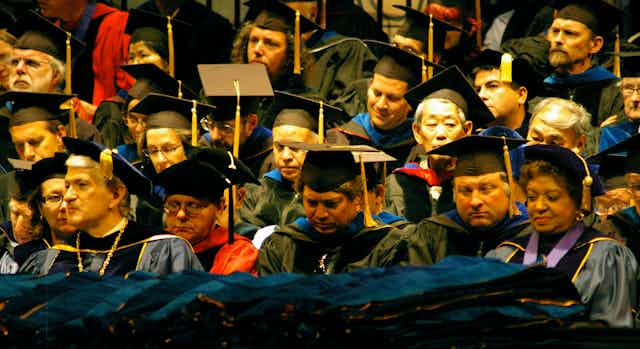The role of the university as a place of education and research, as an employer, and as an important part of the social landscape has changed dramatically in the past decade.
As PhD students from various European and North American academic backgrounds, we are keenly aware of these developments and have been involved within or against them – often both at the same time. One of the most pressing issues from our perspective is that of the workforce in universities, especially the collapse of working conditions for many academic and non-academic staff.
Professors, who once enjoyed excellent working conditions in Europe and North America, are now being subjected to stricter, stranger, and more noxious standards. They are pressured into constant external grant applications, and are threatened with severe sanctions if the administration considers the results of this search inadequate. The case of Stefan Grimm, a professor at Imperial College London who was found dead in September 2014 shortly after a distressing email exchange about funding, is one tragic example.
Professors are increasingly being judged according to various forms of ranking, both state sponsored (such as the Research Excellence Framework in the UK) and international ones such as the Shanghai ranking and the Times Higher Education ranking of global reputation. These rankings, as Cambridge historian Stefan Collini argues, do not actually reflect the excellence of the research, or the quality of the university. And yet, they matter tremendously to university administrators, students, and state officials.
Working conditions under strain
Of course, professors are not the only academic workers at a university. There are throngs of other individuals involved in the production of knowledge. These include temporary teaching staff, “research assistants”, or graduate students who often combine their own thesis-related work with teaching and with non-thesis related “research assistance”. It has been argued that some of these schemes provide valuable experience for graduate students, allowing them to be more competitive in the clogged-up academic labour market.
But this experience can come with unpleasant strings attached, such as less than adequate working conditions. Or teaching opportunities without pay, as recently proposed by our own institution, the European University Institute.
Temporary teaching staff are frequently employed in dire conditions, as in the United States, but also in the “social-democratic paradises” of Scandinavia. High competition, low pay, few to no benefits and very unstable contracts have become the rule, rather than the exception. In Norway, for example, as much as 20% of all university and college employees are hired on temporary contracts.
Such harsh conditions make it particularly difficult for members of historically disadvantaged groups, such as women, people from lower social classes, and those with a migrant background to succeed, as they are the ones most affected by the low pay and lack of benefits. The result is a less socially and intellectually diverse university.
Labour issues boil over
We should not forget that an often neglected but huge part of the university-employed labour force consists of non-academic staff. As an institution, the university does not simply produce knowledge – it also consumes a vast amount of services. These run from university administration to cleaning and catering.
The workers who perform these tasks are to a significant extent, the life-blood of the university. And yet their important contribution often remains unnoticed even when their working conditions, and therefore their livelihoods, are being attacked, as has happened in recent years. As with young academics, those who are overwhelmingly affected by these degrading labour conditions come from underprivileged backgrounds. They are often women, migrants or both and do not usually have ready access to the media to fight back.

In late 2011, in Montreal, members of the McGill University Non-Academic Certified Association went on strike for almost four months. They did so in opposition to a new contract proposed by the administration. The university wanted wage cuts in real terms, and negative (or dangerous) changes to benefit schemes including pensions.
Across the Atlantic in 2013, students and staff at the University of Sussex, occupied a medical school lecture theatre, protesting against the university’s continued privatisation of services that threatened working conditions of staff including porters, caterers and security workers.
State-led privatisation
The responsibility of national governments for “marketisation” and the drive for privatisation in higher education is sometimes underestimated, both within and outside academia. Reforms aimed at privatisation are very often the result of government intervention in the management of universities, and have been imposed from the top down. This has been done by governments of both the centre-right and the centre-left.
Similarly, resistance to these trends comes from both a diverse alliance of the radical-left, who draw on theories of financialisation and neo-liberalism to explain our current economic situation, and from more conservative scholars who see themselves as the protectors of ancient academic tradition.
As young scholars, we are part of the university’s future. It seems evident to us that we should ask questions about what universities are for. But in so doing, we must not forget to ask another, bolder question: “what should universities be?”
There is no “going back” to any perceived golden age, but it is beyond doubt that there are aspects both of the academic tradition and of the post-war ideal of affordable or free higher education that are worth defending. As institutions charged with the important task of producing new knowledge, universities should not be desperately mimicking already outdated forms of corporate organisation, but rather be leading the way towards something better.
This article was written with the assistance of Tiago Matos, Kimon Markatos, Hannah Elsisi and Tommaso Giordani. It is part of a series on Universities at the crossroads.

